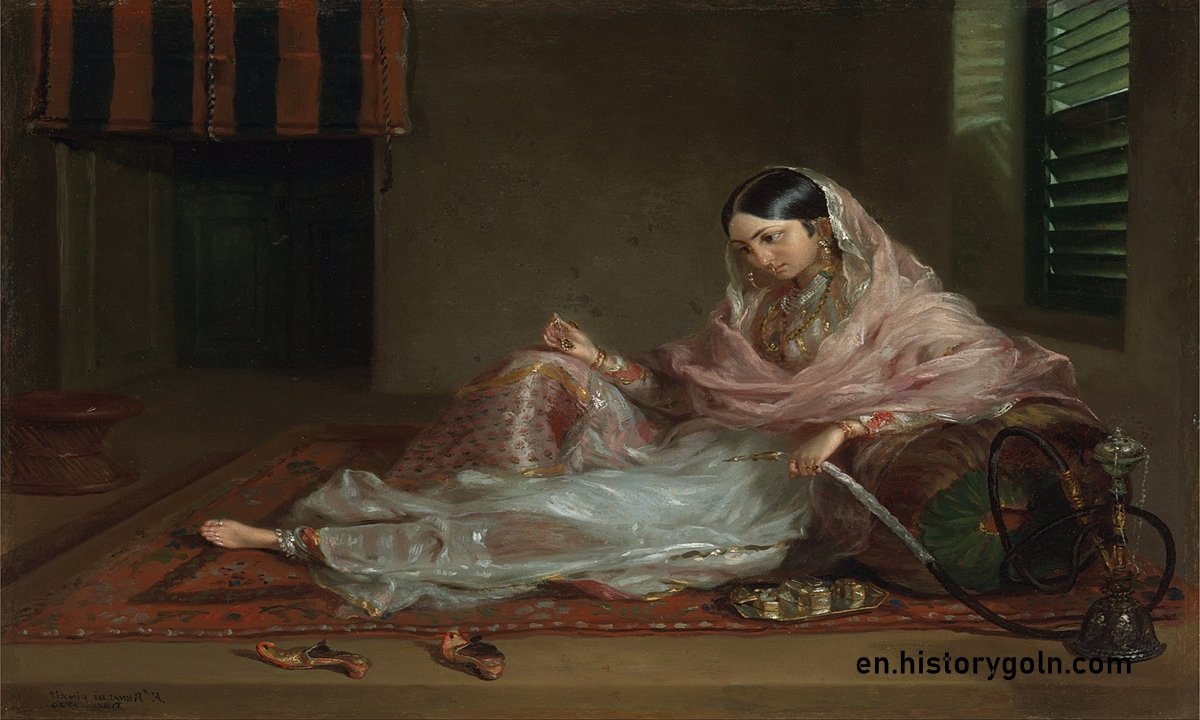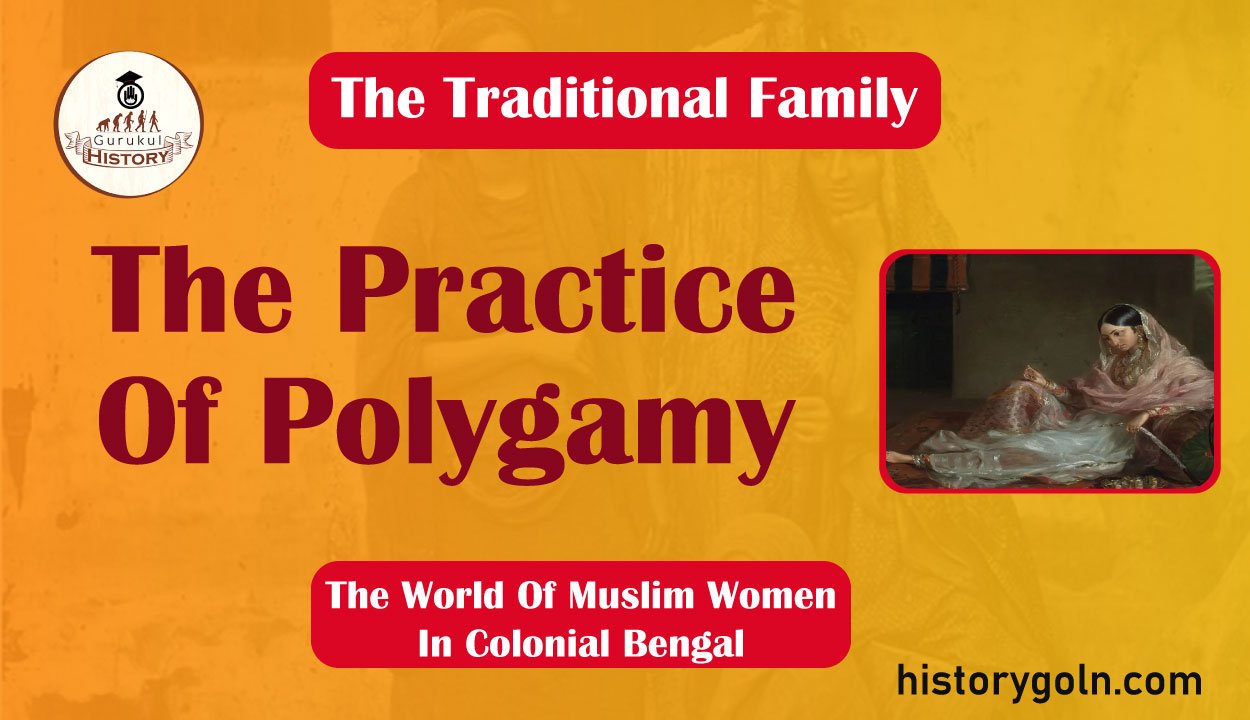Today our topic of discussion is The Practice Of Polygamy .
The Practice Of Polygamy

Islamic scriptures allowed polygamy in the exclusive sense of polygyny quite clearly although as some Koranic scholars writing at that time pointed out – under certain circumstances and certain conditions.
In India, polygamy was by no means a Muslim monopoly, as pointed out by scholars such as Kumari Jayawardena,48 Kulinism’ in Hindu society could often lead to a man having several wives. Official reports such as the censuses revealed that cases of polygamy were to be found in Hindu society also.
Right upto the twentieth century polygamy was accepted as a norm and it was customary for a woman to have a co-wife or sateen, as did Faizun-nessa and Kulsum Bibi. Hunter’s statistical account of Tipperah district published in 1876, referred to the practice: Polygamy is of course permitted among the Muhammadans. If the first wife is quarrelsome or ugly, or if there is a great deal of household work, a second wife is required.
Throughout the nineteenth century, judging from literary evidence, the prospect of a co-wife was not always great cause for concern. Many of the educated Muslim bhadromohila of the twentieth century, in their writings or interviews, referred to grandmothers who had sateen.
Some ambivalence, however, always surrounded the issue. As early as 1867 Munshi Namdar in a piece ‘Dui Sateener Jhagrha’ (A Quarrel Between Two Co-wives) cautioned readers about the discord that might ensue from practising polygamy,
Nausher Ali Khan Yusufzai who may be considered a notable social analyst of the day by dint of his nineteenth century treatise on the Muslim community Bangiyo Musulman (1890), referred to the practice of polygamy:
Our gaze has not yet turned to the poisonous effects of polygamy the chief of which are production of too many children, domestic dissension and female suicide…. the incidence of polygamy is not small by any count in this country. Among the Muslims of Bengal for every 1000 married males there are 1033 married females, ie, 4% of marriages are polygamous.
Ibrahim Khan in a section titled ‘Bohubibaho (polygamy) wrote about the practice of having several wives in the preceding generations, among high born and low born alike:
In days of yore, girls only thought it natural that healthy, well-to-do young men would have several wives, and they conditioned themselves accordingly. Sometimes the relation between co-wives would be one of great love and respect… However sometimes there would be cause for discord. He reported a lament he had heard from a co-wife, which showed the tension between old values and new:
Do you know what my educated brother said when I accusingly asked how he could have agreed to give me away in marriage to a man who already had a wife? He said ‘Oh, be quiet. Our paternal grandfather had three wives, and our maternal one had two.
We are quite familiar with the custom. Perhaps the “graduate” brother did regret the sister’s marriage to such a man, but what can one say. if this is the way in which he evaded the question! Syeda Monowara Khatun in her short memoir also referred to polygamous: marriages in the family’s past, in the latter half of the 19th Century:
Let me describe the zamindar household into which my elder sister was married. My brother-in-law had four or five mothers. His father’s first wife was called Badrunnessa. But brother-in-law’s father was a debauchee, whiling his days in wine and women. If ever he chanced upon a pretty girl who took his fancy he married her. According to Monowara, all these events took place around 1850, long before her birth in 1909 (1316 BS).

Monowara described Badrunnessa’s wifely duties and life in the andarmahal. She had heard these narratives from one of Badrun’s co-wives, Monowara reminded the reader that these were not tales but facts, albeit, gathered from an indirect source. Though there was a train of servants and maids, Badrun attended to all her husband’s needs herself, her sole creed was wifely devotion.
She dressed the younger co-wives, did up their hair and sent them in to their lord. Badrun was educated she administered the estate from behind a curtain. One day Badrun’s husband who already had four wives returned with another. When news of this was sent to the andar, Badrun came and pleaded to her husband:
You already have four wives and shariat allows only that many. Divorce me then before you receive the new bride she is young and fresh. The husband trapped, (Monowara reminded the reader at this point that the estate belonged to Badrun’s father) sent the new bride away.
When Badrun’s husband was 50 years old he married a girl of seven and Badrun almost ‘raised the child by teaching her how to do household work, to read the Koran, to offer prayer, to please one’s husband, etc. Such was Badrun, an epitome of the matriarch. The pattern of Badrun’s domestic life was repeated through her step-son Mahmud, Monowara’s brother-in-law.
Unfortunately, Syeda Monowara Khatun never got to the point of her own marriage in her memoir though she did describe her struggle after her widowhood. Her husband, who served under colonial administration, took only one wife.
The olden days of case and comfort were fast vanishing for the sharif households and Monowara widowed rather early found herself in dire straits. To make ends meet she took up a job and thus raised her family. Monowara’s life reflected the womanhood in transition, part old and part new.
By the first decades of this century when a section of the Muslim society had made the transition to modernity, the English educated Muslim bhadrolok, started to look upon the practice of polygamy with some disfavour. Gradually its occurrence became rarer among the educated class. This can be gleaned from the debates on the issue in contemporary perio- dicals. Monogamy was fast becoming the marital norm. The Census of India reviewed the situation thus:
in practice except among wealthy Muhammadans, a second wife is very rarely taken unless the first one is barren or suffers from some incurable disease… The excess of wives is greatest among Muhammadans (21 per mille) in case of Hindus and Buddhists it is only 8 and 7 per mille respectively.
That attitudes to polygamy had undergone changes were apparent from gleanings from the popular press. The popular press itself represented diverse views ranging from the orthodox to the liberal, and various shades in between.
Often a certain individual or periodical harboured views that were conservative on some issues and liberal on others. Conversely, individuals and journals that had very different ideological stands, agreed surprisingly on a single issue. One point was clear: the practice of polygamy as a form of marriage was increasingly being questioned.
The liberal reformists referred to by the orthodox as the nabya Muslim were deeply stirred by the Bengal Awakening and advocated modernization along rational-utilitarian lines, not, however, violating religion as they interpreted it. The most vocal mouth-piece of the orthodox camp was the Sudhakar group which published Sudhakar (later Mihir Of Sudhakar).
The Islam Pracharak, also conservative, published in its 1903 issue an article by Sheikh Jamiruddin criticizing polygamy. The writer no longer saw any religious or political justification for the continuance of polygamy. Jamiruddin pointed out that in the vast province of Bengal inhabited by almost 30 million Muslims, only 10% to 15% practised polygamy. He deplored the situation which led to the tyranny of co-wives and resulted in suicide:
In whichever light we view the matter, man and woman have equal rights. Then why do men perpetuate such an oppression and injustice on women that violates the law of Nature and God? True, Islam sanctions polygamy, but have we forgotten the conditions and circumstances under which it is permissible?57
The ‘liberal’ literary monthly Nabanur also joined in the discussion.
In “Bohu-bibaho, the writer Emdadul Huq started off with the natural sexual attraction between man and woman, and celebrated this ‘lila’ (manifestation of God’s creativity), which was socially harnessed and channelized into the production of offspring through the holy bond of matrimony.
The distinc- tive feature of this article was that it provided a historical argument against polygamy, viz, apart from its ill effects on the creative, social and altruistic side of a human being, polygamy fell into disuse as societies advanced along the scale of human civilization. He commented:
In Europe, Christian society sanctions monogamy; Muslim society sanctions polygamy (four wives) and in Hindu society Polygamy is not unknown. The rigid regulation of matrimonial law by the promulgation of monogamy testifies to the advanced state of European Civilization and the elevated taste of its denizens. But does that mean the norms and laws of marriage in our country. become meaningless and futile .
In answer to this very topical question the writer outlined the original causes for allowing polygamy in Islam and the conditions under which it was allowed. The conclusion drawn was that the circumstances under which the Koran allowed polygamy existed no more and the conditions were well near impossible to meet. Therefore, the author argued that in actuality Islam favoured monogamy.
He however proceeded to give a dainty twist to his argument whereby provisions for polygamy were seen as a beneficial safety-valve for a society in curbing adultery and licentiousness. Demographic factors (male female ratio), female sterility, excessive lust in some individuals, etc., were cited as rationale for sanctioning (conditional) polygamy.
The writer did not hesitate to say that this special provision in fact protected Indian society from the licentiousness and loneliness that visited many men and women in the West. Polygamy according to him was better than adultery, fornication and illegitimate offspring. Thus were the tables turned and indigenous structures defended against a ‘denigrating’ and condescending ‘Western’ cultural outlook which condemned indigenous
customs and values.
In the main, however, orthodox and liberal stands concurred at this point, on the issue of polygamy (as we have already seen and we shall see later on many other issues of reform in Muslim society: child marriage, women’s education, erosion of purdah, women’s rights, etc.). The conser- vative and liberal strands were both part of a broader reformist project.
The omnipresent social critic Ismail Hussain Shirazi could not let the matter pass without writing on it. He declared that the most scientific marriage was one where bride and groom selected each other.59 This type of selection was also sanctioned in Islam according to him. However, he also added that certain circumstances i.e. wife’s sterility, or chronic illness, sometimes justified polygamy,
It is interesting to note that, during the early twentieth century, most instances in popular fictional literature (Anowara, Swapnodrishta, Abdullah, Atmadan) were those of monogamous couples, though co-wives were also portrayed. Some of the fictional pieces went so far as to paint the polygamous man as a hypocrite and lecher (details to follow: Chap. VII).

An issue that was closely linked to polygamy was concubinage, or the so- called Bandi Protha. In Bengali, ‘Bandi’ literally means “bonded females’. They were found in abundance in rich households. Rokeya’s father Abu Ali Saber had four wives and several bandi according to Munshi Aftabuddin’s punthi, “Payraband Kahini”, and Moshiuzzaman Saber’s family history of Rokeya’s ancestors.
According to the chroniclers, extravagance, luxury, and concubinage led to the fragmentation and final bankruptcy of the Saber zamindari. Rokeya writing much later never referred to these events. Emdadul Hug in the article referred to above condemned the custom of concubinage and said that those who claimed that it was an Islamic custom, were guilty of falsehood.
See more:
